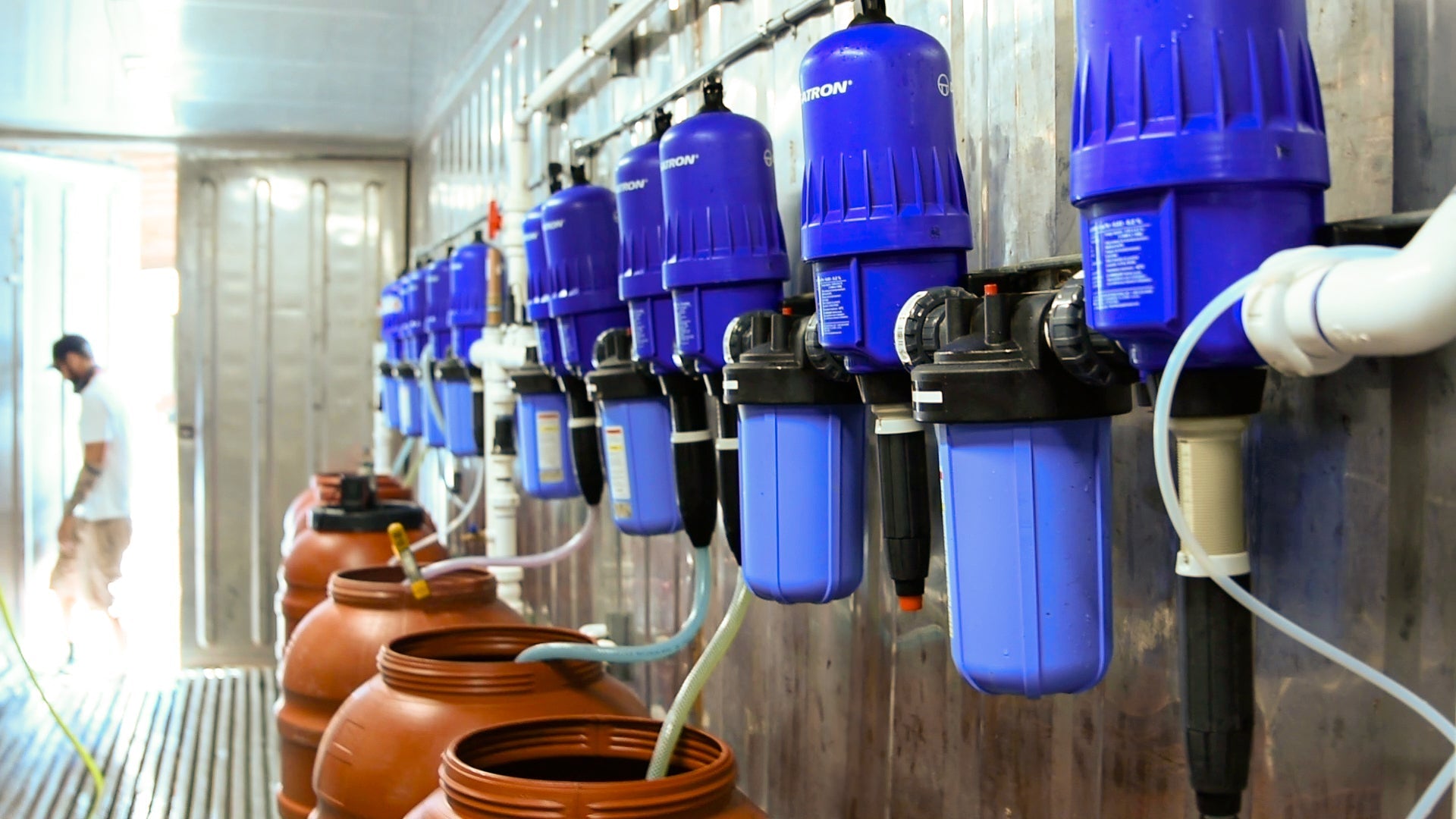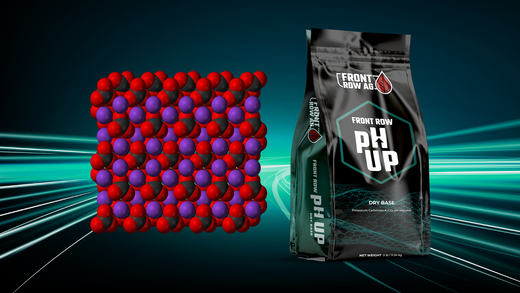Front Row Ag Feed Charts provide precise nutrient management protocols for controlled environment agriculture. This technical guide covers stock concentrate methods (3-2-2) and direct-to-reservoir (DTR) approaches, along with phase-specific recipes designed to optimize plant performance throughout the growth cycle.
Quick Start Guide
- Choose Your Mixing Method:
- Stock Concentrate: For consistent, large-scale operations
- Direct to Reservoir: For smaller operations or specialized requirements
- Select Strength Level:
- Standard Strength: General purpose
- High Strength: Intensive cultivation environments, highly controlled facilities
- Determine Recipe Strategy:
- Stack Recipe: Simplified management, consistent results
- Phase-Specific: Optimized for particular growth stages or cultivar types (short/tall size and early/late flowering)
Understanding Component Relationships
Key Points:
- Components work synergistically
- Ratios adjust to match growth phases
- Enables precise crop steering
Front Row Ag's three-part system creates a complete, balanced nutrient profile through the interaction of:
- Part A: Drives vegetative growth and provides essential micronutrients
- Part B: Supports structural development and energy systems
- Bloom: Enhances reproductive growth and secondary metabolism
The ratio between these components can be adjusted to:
- Influence growth patterns
- Support specific developmental phases
- Enable precise crop steering
- Optimize plant responses
Feed Chart Fundamentals
Key Points:
- EC requirements vary with cultivation factors
- Standard and High Strength options available
- Component ratios drive plant responses
Strength Selection Factors
| Cultivation Factor | Higher EC | Lower EC |
|---|---|---|
| Container Size | Reduced | Larger |
| Irrigation Frequency | Higher | Reduced |
| Leachate Monitoring | Consistent | Limited |
| PPFD Levels | Enhanced | Moderate |
| CO2 Conditions | Elevated | Ambient |
| Environmental Control | Tight | Variable |
| Genetics | Heavy-feeding | Light-feeding |
Stock Concentrate Methods
Key Points:
- 3-2-2 is standard for most facilities. Reach out to your sales rep if you require more concentrated stock solution or specfic injection ranges.
- Stock concentrates aren’t just for injection - they’re also the best choice for time savings, accuracy, and consistency for facilities that mix batch tanks by hand.
- Use only RO water at ~71°F
- Validate EC after mixing
- Store for up to 2-4 weeks
Stock Concentrate Methods
| Method | Component | Bags (25 lb) | Water Volume | Validation EC |
|---|---|---|---|---|
| 3-2-2 | Part A | 3 | 50 gal | 2.9 |
| Part B | 2 | 50 gal | 1.5 | |
| Bloom | 2 | 50 gal | 1.2 |
Critical Mixing Parameters
For both methods, precise measurement and proper mixing procedures are essential:
- Use only RO water at ~71°F
- Fill tanks to 50% of target volume before adding fertilizer
- Maintain continuous agitation during mixing
- Mix for 5 minutes while adding fertilizer
- Continue mixing for 10 minutes after reaching final volume
Validation Process
Stock concentrates must be validated before use to ensure proper mixing:
- For most accurate results, mix 250ml of stock concentrate into 5 gallons of RO water
- Check EC against validation values for your chosen method
- Higher validation values for 4-3-3 reflect the increased concentration of stock solutions
Direct to Reservoir (DTR)
Key Points:
- Requires precise measurement
- Follow mixing sequence exactly
- Use within specified timeframes
- Monitor solution stability
Mixing Process
Proper mixing sequence is critical for DTR applications:
- Fill reservoir to target volume and begin agitation
- Add Front Row Si (if using)
- Add Part A and agitate for 3-5 minutes
- Add Part B and agitate for 3-5 minutes
- Add Bloom and agitate for 3-5 minutes
- Adjust pH using pH Up in 0.05 g/gal increments until reaching target pH (typically 5.8-6.0). Wait 15 minutes after mixing to validate.
- Validate final EC and pH
Solution Storage Guidelines
| Solution Type | Storage Time | Storage Requirements |
|---|---|---|
| Stock Concentrates | 2-4 weeks | Opaque containers; climate-controlled area |
| DTR without Si | 5-7 days | Opaque containers; climate-controlled area |
| DTR with Si | 48 hours | Opaque containers; climate-controlled area |
Water Quality and Sanitization
- Use only RO water for mixing
- Avoid using hydrogen peroxide or other strong oxidizers, as these can degrade micronutrients
- For sterile reservoir management, calcium hypochlorite at 1-3g/100 gallons is recommended
Feed Recipes and Phases
Key Points:
- Stack recipe suitable for most applications
- Phase-specific recipes optimize growth responses as part of a crop steering strategy
- EC typically decreases through flower cycle
- Recipes support crop steering goals, providing vegetative and generative cues at strategic times
Growth Phase Characteristics
| Recipe | Primary Purpose | Key Features | Best Used For |
|---|---|---|---|
| Veg | Vegetative Growth | High N ratio; supports photosynthesis | Initial growth phases; mother plants |
| Stretch | Vertical Development | Balanced ratios; promotes elongation | Compact strains during stretch; canopy development |
| Stack | Full-Cycle Performance | Consistent ratios; simplified management | Standard production; most strains |
| Swell | Flower Development | Enhanced P-K ratio; balanced nutrition | Mid-to-late flower optimization |
| Ripen | Finishing | Reduced N; enhanced secondary metabolism | Late-stage development; long-flowering strains |
EC Progression Through Growth Cycle
Feed EC typically starts higher in early growth stages and gradually decreases through the cycle. This pattern aligns with natural plant demands:
- Early stages (veg and first three weeks of flower) have highest nutritional requirements due to rapid growth and smaller root mass
- As plants complete stretch phase, mineral requirements naturally decrease
- Later stages benefit from reduced EC and/or increased runoff to manage substrate EC
Additives
Key Points:
- Each additive serves specific functions
- Follow usage rates carefully
- Consider compatibility with growth phase
- Monitor plant responses
Front Row Si
Front Row Si provides highly available monosilicic acid (MSA), the only form of silicon directly absorbable by plants. Key features include:
- Delivers 13ppm of soluble silica at recommended rates
- 10x more concentrated than conventional silicate products
- No additional potassium contribution
- pH neutral formulation
- Contributes to:
- Mechanical strengthening of plant tissues
- Enhanced stress tolerance
- Improved disease resistance
- Better nutrient absorption
Phoszyme
Phossyme is a specialized enzyme product containing mannanase and phosphatase that enhances nutrient availability and uptake. The best way to use Phoszyme with the 3-2-2 stock method is to mix it in the Part B stock solution at 54 g/gal (6lbs per 50 gal). Note that this will increase the stock validation EC to 1.69 EC.
Benefits include:
- Improved water and nutrient absorption
- Enhanced fertilizer efficiency
- Increased microbial activity in the rootzone
- Better stress and drought tolerance
- Enhanced production of secondary metabolites
The dual-enzyme formulation works through:
- Mannanase: Breaks down root zone starches to improve water and nutrient flow
- Phosphatase: Catalyzes phosphorus conversion for better availability
Triologic
Triologic is a microbial root inoculant designed to enhance plant growth through mycorrhizal colonization. This concentrated formulation contains specialized rhizobacteria that:
- Fix nitrogen and cycle essential nutrients
- Facilitate nutrient uptake
- Enhance fertility
- Improve plant resistance to pests and diseases
- Support mycorrhizae formation and beneficial fungal colonies
Application:
- Recommended rate: 1 ml/Gal (0.26 ml/L), once per week
- Best applied as a hand water drench
- Most effective when applied early in plant development
BioFlo
BioFlo is a biological cleaning solution designed specifically for irrigation systems. This enzyme-based formulation:
- Clears biofilm and salt buildup from irrigation lines
- Restores irrigation systems to full capacity
- Safe for plants, soil, and beneficial microorganisms
- Compatible with all injection and tank systems
- Effective for both prevention and treatment of clogs
Key Benefits:
- Natural bio-enzyme action
- No harmful chemicals
- Safe for use throughout the growing cycle
- Effective against existing clogs and preventative for future buildup
- Maintains clean, efficient irrigation systems




